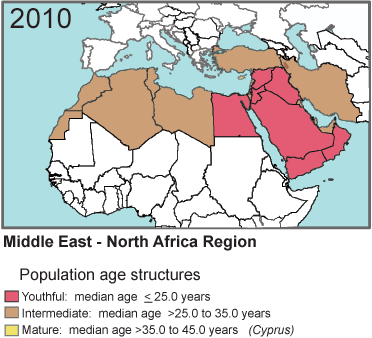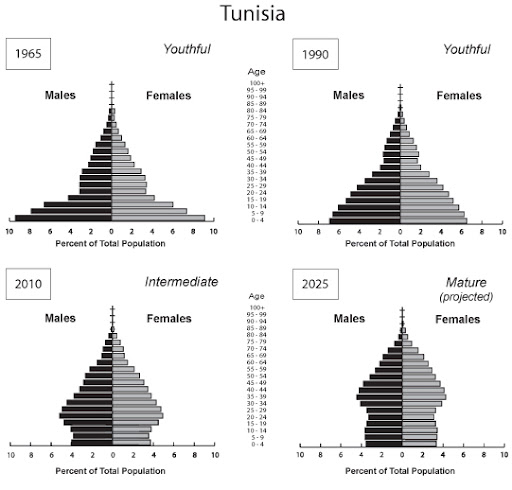-
Tunisia’s Shot at Democracy: What Demographics and Recent History Tell Us
January 25, 2011 By Richard Cincotta
While events in Tunisia, beginning mid-December and leading ultimately to President Ben Ali’s departure within a month, have rocked the Arab world, they leave an open question: Will Tunisia’s “Jasmine Revolution” ultimately lead to the Arab world’s first liberal democracy? [Video Below]
If the relationship between demographic change and democratic liberalization remains as robust as it has over the past 40 years, the odds are in Tunisia’s favor. South Korea, Taiwan, Chile, Indonesia, and Brazil were at a similar stage of age-structural maturity when each ascended to liberal democracy. If this political-demographic rule functions similarly in North Africa (see age-structural predictions for North Africa in a prior ECSP publication), then the likelihood of Tunisia achieving a liberal democracy – that is, a state assessed as “free” in Freedom House’s annual assessment – is high, relative to countries in other parts of the Arab world.
According to Freedom House, a free country is one “where there is open political competition, a climate of respect for civil liberties, significant independent civic life, and independent media.” On a scale of one to seven, seven being the most autocratic, Ben Ali’s regime scored a 6.0 (assessed in 2010).
The Demographic Factor
 Is it possible that a single factor could communicate so much about a nation’s future? In fact, a country’s age structure (the distribution of the population by age) is anything but a single factor. It is, instead, somewhat like a running tally of age-specific variations that have been produced by an array of factors influencing birth, death, and migration over the length of a human lifespan. Many of these factors – including family size, educational attainment, income, workforce growth, and the ratio of dependents to workers – critically influence the path of human development and mediate progress toward a functional, modern state. Moreover, each factor affects the others in complex ways.
Is it possible that a single factor could communicate so much about a nation’s future? In fact, a country’s age structure (the distribution of the population by age) is anything but a single factor. It is, instead, somewhat like a running tally of age-specific variations that have been produced by an array of factors influencing birth, death, and migration over the length of a human lifespan. Many of these factors – including family size, educational attainment, income, workforce growth, and the ratio of dependents to workers – critically influence the path of human development and mediate progress toward a functional, modern state. Moreover, each factor affects the others in complex ways.How long could it take Tunisia to move from Freedom House’s “not free” category (7.0 to 5.5) to “free” (2.5 to 1.0)? South Korea ascended in five years (1983-88). For Indonesia, the same journey took eight years (1997-2005), and for Taiwan, it took over 15 years to inch through the partly free category to free (1980 to 1995). Recent European ascents were somewhat quicker: Poland took four years (1987-91); Romania, six (1990-96); Portugal, three (1973-76); and Spain, four (1973-77). Greece jumped from not free to free in only one year (1973-74), following the collapse of a repressive anti-communist military regime.
To understand how age structure can directly influence a state’s chances of attaining and maintaining liberal democracy requires a discussion of two models of sociopolitical behavior: (1) the Hobbesian bargain and (2) the youth bulge thesis.
Assuming, as the English political philosopher Thomas Hobbes did in the middle of the 17th century, that citizens are willing to relinquish political liberties when faced with threats to their security and property (the Hobbesian bargain), it is not surprising that support for authoritarian regimes – especially among commercial and military elites – appears high when societies are very youthful and prone to political violence (the youth bulge thesis). When fertility declines, the population’s bulge of young adults ultimately dissipates over time. With much of society’s political volatility depleted, authoritarian executives tend to lose the support of the commercial elite, who find the regime’s grip on communication and commerce economically stifling and the privileges granted to family members and cronies of the political elite financially debilitating.
Good News, Bad News
What does this mean for Tunisia? First, the good news: Despite journalists’ focus on youth in the streets, Tunisia is not a youth-bulge country. Its population’s median age is 29 years – exceedingly more mature than the populations of most states in the Arab Middle East, such as Yemen (median age of 18 years), the Palestinian Territories (18 years), Iraq (19), Syria (23), and Jordan (23). Tunisia’s consistent declines in fertility pushed it into the class of intermediate age structures in 2005.
 Intermediate age structures (also known as “early worker-bulge” populations) are distinguished by having a median age between 25 and 35 years. In its most recent report, Freedom House assesses about half of these states – which include Brazil, Colombia, Indonesia, and Turkey – as free; the other half are partly free or not free. According to the UN Population Division’s database, several countries in the Arab Gulf region – Kuwait (partly free), Qatar, and Bahrain (not free) – also have age structures that fit into this “intermediate” classification. But this is misleading; the Gulf states’ median ages are inflated by the presence of large numbers of temporary labor migrants in the prime working ages. Tunisia and Lebanon share the distinction of having the eldest native populations in the Arab world. Better yet, Tunisia does not suffer Lebanon’s difficulties with internal (Hezbollah) and external (Syria, Israel, and Iran) actors.
Intermediate age structures (also known as “early worker-bulge” populations) are distinguished by having a median age between 25 and 35 years. In its most recent report, Freedom House assesses about half of these states – which include Brazil, Colombia, Indonesia, and Turkey – as free; the other half are partly free or not free. According to the UN Population Division’s database, several countries in the Arab Gulf region – Kuwait (partly free), Qatar, and Bahrain (not free) – also have age structures that fit into this “intermediate” classification. But this is misleading; the Gulf states’ median ages are inflated by the presence of large numbers of temporary labor migrants in the prime working ages. Tunisia and Lebanon share the distinction of having the eldest native populations in the Arab world. Better yet, Tunisia does not suffer Lebanon’s difficulties with internal (Hezbollah) and external (Syria, Israel, and Iran) actors.How did Tunisia get ahead? New York Times correspondent David Kirkpatrick said it so well, that I’ll simply quote his statement about Habib Bourguiba, the country’s first president and the father of its broad middle class:
[Bourguiba] pushed a social agenda of secularization, women’s rights, birth control and family planning that, in contrast to most countries in the region, slowed population growth, keeping the job of public education and social welfare manageable.
Bourguiba’s reforms reshaped the country’s pyramidal population age structure into the intermediate structure that Tunisians experience today (see figure above).
Now for the bad news: Tunisia’s ascent to liberal democracy is still uncertain. In the annals of history, nearly all of the youth-led revolts aimed at achieving liberal democracy have fallen far short of their mark. Instead, they tend to descend into infighting and typically produce a partial-democratic or autocratic regime capable of quelling violence and limiting the destruction of property. This tendency lays bare the most serious limitation of an age-structural theory of democratization: ultimately, personalities and political action – non-demographic factors – are needed to consolidate elite and popular support for a liberal democratic regime. To eventually attain liberal democracy, Tunisia’s political elite, or what remains of them after years of expulsion and political exclusion under the Ben Ali regime, must seize the democratic initiative from demonstrators and make it their own.
But wait a minute, you might say: Wasn’t the Jasmine Revolution triggered by Mohamed Bouaziz’s martyrdom and a series of Wikileaks highlighting the Ben Ali regime’s nepotism and corruption? In “real time” these were instrumental – and so were the internet and news media that delivered them into households in all corners of Tunisia and throughout the Arab world. But triggers like these are often unique and nearly always unpredictable. As such, they offer little assistance to serious analysts hoping to predict the timing and success of future democratic transitions. Instead, they are the grist for today’s journalism and tomorrow’s history.
What’s Next?
While some democracy pundits are gloomy about the country’s prospects, political demography’s age structure model gives Tunisians a good chance – perhaps even within five years – of achieving the Arab world’s first liberal democracy. Right now, the evolution of Tunisia’s political future depends on how its military, political, and commercial elites handle this opportunity. In the United States, some analysts worry that open political debate, free and fair elections, and rule of law might ultimately end up delivering another government into the hands of Islamists, a group that tends to make gains in the wake of corruption, and one that Ben Ali actively suppressed. This may be a moot point: There are many in U.S. foreign policy circles who are convinced that the Arab world needs a liberal democracy much more than Washington needs another friend.
For now, those outside Tunisia can only watch and wait. But if you’re watching, do some political demography of your own: Demonstrations that feature young women, the middle-aged, and perhaps even entire families, are a sign that democracy is on its way. Crowds entirely dominated by young men and boys – the social remnant of Tunisia’s waning youth bulge – tell a different story.
Richard Cincotta is a consulting political demographer for the Wilson Center’s Environmental Change and Security Project and demographer-in-residence at the Stimson Center.
Sources: Canadian Press, CIA World Factbook, Freedom House, The New York Times, U.S. Census Bureau, UN Population Division.
Photo Credit: “077,” courtesy of flickr user Nasser Nouri, and maps courtesy of Richard Cincotta and the UN Population Division.
Topics: democracy and governance, demography, featured, Middle East, population, security, Tunisia, video, youth
 A Publication of the Stimson Center.
A Publication of the Stimson Center.





